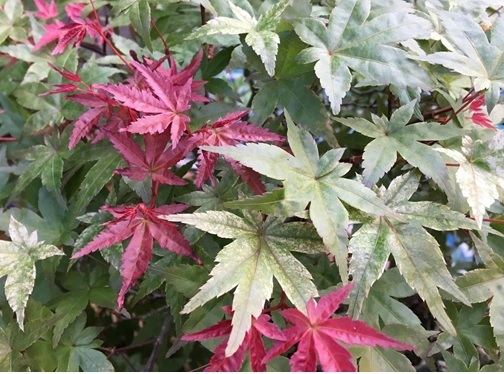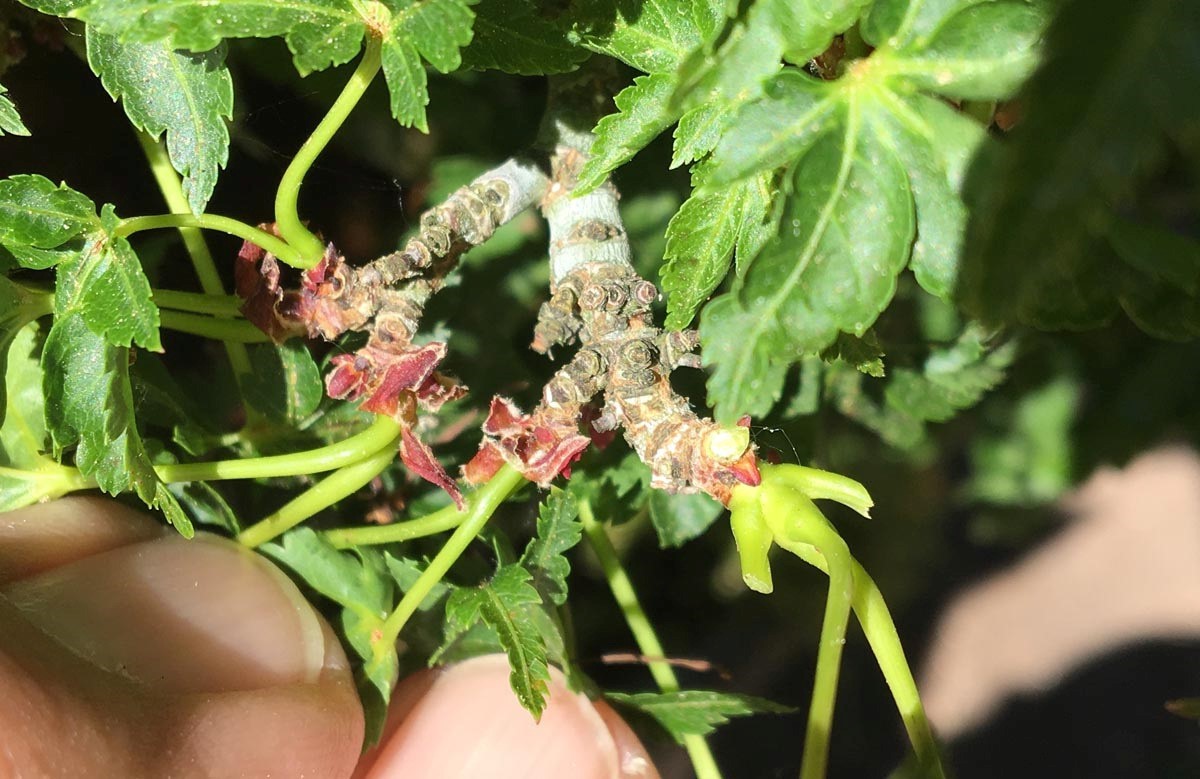Well, here we are, rather stranded by COVID. For many of you, including myself, it has led to more time with the bonsai. I am really looking forward to seeing the results in your trees with all of this time at home. I know that my bonsai have really taken off this spring at an unprecedented pace and I have been barely been able to juggle repotting, pinching, pruning, styling, etc… The spring weather certainly has been cooperating with a mild winter and a dryer and warmer than usual spring. This has accelerated the development calendar by a few weeks so that buds on different species have emerged and elongated nearly simultaneously, it seems. I barely get my maples in refinement pinched then the spruce start running and it’s time to pinch them too. Then there are the firs and hemlocks.
I actually started experimenting with extending my pinching regimen to species I usually just pruned after hardening. Many of those are now transitioning from a developmental mode into a refinement mode. Which really means that I am moving from developing the trunks into developing quality branching, especially on deciduous trees that I have grown from scratch.
A refined Sargent’s crabapple with its first crop developing
Let’s start with fruiting trees. My regular habit is to prune off any fruit that starts to form so that it does not take any energy away from my primary goal of developing trunks or branches. However, I was very pleased to see tiny apples forming on one my shohin Crabapples in refinement for the first time. The fruit only develops on second year spurs, so as I pruned for refinement year after year, I was pruning away all the flower buds. This was a known tradeoff, but the results are worth it. This year I pruned the branches just past the fruit to check their growth, and am praying that the tree does not respond by aborting the tiny, quarter inch apples. So far, so good.
But I regularly prune off all the flowers of my plum trees, knowing that a few escape and develop fruit anyway. These trees are now getting close to where I would allow them to develop fruit. However, the fruit tends to ripen mid-summer when there is no one around to share it with, but the birds, so off it comes. I did get to enjoy the sweet flesh myself, one year. Full size apples and pears pull a lot of energy from the tree. Be wary about what you let grow.
Placing tall plants inside of a second container to prevent blowing over.
You must also consider how great a target they make for critters, who seeking sustenance, wreak havoc trying to get at your fruit. A huge black crow landed on a newly repotted juniper yesterday and I was so glad that it was both tied into the pot, and tied down to the bench. I would have hated to lose the new pot after just a few weeks.
At the time of this writing, most of my deciduous trees have hardened off their initial growth and are continuing to push. I have some of the aforementioned shohin crabapples in development that have rather tall spikes of growth (3 feet) to thicken up the trunks. Because I am developing them as shohin, the pots are still small, so the wind likes to blow them over. In the past, I took this as a cue to repot the tree into a larger pot.
The same shohin tree in development under all those long branches.
The problem is that the tree does not have enough foliage mass to take up all of the water that a larger pot will hold and they stay too wet. Since I am growing these trees in terra cotta pots, one of the simplest ways to handle this is to simple place it inside a pot of the next size up, them just a quick wire around to keep everything together. This has proved very effective and set me up perfectly when I prune off the sacrificial spur, being left with a small tree again.
My fertilizing has been a little off this year. I haven’t really started until now, because I wanted to keep my trees more in refinement. However, there are some trees that I really want to make some hard prunes on to redirect growth and initiate a dynamic and profuse response. Those I should have been fertilizing since they first started growing. My mistake in the past has been to make a big prune without fertilizing appropriately. The response I would get from the tree is meager and not consistent. So, while I want to prune really badly, I am going to wait a few weeks and build up their strength.
What I do have going well for me is that I did fertilize strongly in the fall, which is why everything has pushed so well this spring. I will start by pruning my Japanese maples, the ones that I want to keep in refinement. With those, I have already pinched, and pinched, and pinched again, as new growth continues to respond to previous pinches, from strong to medium to weak.
Now that it is hardening off, I am going to take off one leaf of the any pair of leaves, and leave only one internode, unless it is impossibly short (less than a quarter to half inch, depending on tree size). Generally speaking, the tree does nothing in response. We are getting more light to each leaf that is left, so it is doing just fine and it is happy to stay right there for the rest of the year.
A cherry, pruned, then leaves further defoliated by cutting in half.
However, if we want to elicit a growth response, for a new set of growth, we can go back and cut each remaining leaf in half. Remember, anything that is left is still photosynthesizing. So instead of complete defoliation, you end up with about 75%, which should stimulate the tree to put out new growth. You can apply this principle to most deciduous, and even some broadleaved evergreen trees. However, we usually only do this on larger leaved varieties. See the example of the cherry in the photo.
We also need to address watering at some point here. This is the most critical time of year for watering. We have a lot of factors that are in continual flux until things sort of settle down to a regular routine in early summer. As the trees push their buds out, they begin to use more water. Sometimes an immense quantity in just one day. All of the new foliage the tree is adding does not have a cuticle formed, so it can lose moisture rapidly. We have to be spot on with water until the foliage hardens off and is able to retain moisture consistently.
The next challenge we have with water is the darned weather. It rains, then it’s hot, then it rains some more. Trees with a heavy canopy may not receive that much water. I have a large Norway Spruce that sits under the neighbor’s Norway Maple and both the maple and spruce’s own canopies prevent it from receiving much rain water. The neighbors must think that I am crazy, out there watering just one tree when the rain has been going on for hours.
I find that even after raining all morning, that some trees need water in the afternoon, just because they are growing and transpiring rapidly. And the more developed a tree, the more water it will need. And now, here is where caution needs to step in. Once we start pruning, defoliating, etc…, the amount of water the tree needs with temporarily decrease. Also, as the tree hardens off, its need for water will decrease, so we really need to pay attention every day to its changing requirements.
Since the leaves on most of our trees are beginning to harden off, this is also a great time to make air-layers and make large, hard cuts to the trunk or branches. Now that trees are back into an energy positive, where the brand-new leaves that they have just invested in can pay back, the tree is in a position to make a positive response to drastic action. In the case of air layers, the tree can use these new leaves to power the generation of new roots. In the case of drastic trunk chops and defoliating, and drastic pruning, the tree has recharged its batteries so that it can channel energy into generating new buds, redirecting growth, or compartmentalizing and healing wounds.
What do we mean by hardened off? You will see the color of the leaves change and the leaves become firmer. This will start at the base of the branch then continue out to the newest leaves. If we have allowed a shoot to elongate and it has, say, ten leaves on it, we can start to prune back anytime we have four or five leaves at the base that have already hardened off. That’s all we need.
Be aware when you prune that many species will not generate a bud from the first leaf or two. These basal leaves are usually small and it can be better to just remove them, rather than rely on them. They are often a totally different shape than the regular leaves. But sure then, to end up with at least two good leaves when pruning, whether at the same node with species of opposite leaves, like maples, or two separate nodes in alternating leaved species (Almost everything else but maples).
And finally, I know this is getting long, be ready for the water shift in the summer. As we mentioned, plants will begin to harden off and reduce their water usage. Some plants also shift into semi-dormancy, further reducing their water usage. Another shift will occur any time we perform decandling or defoliation techniques. Each tree is different and will shift at different times.
Have a great, growing spring. I look forward to seeing all of you and your bonsai results soon.
Scott Elser













